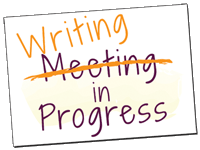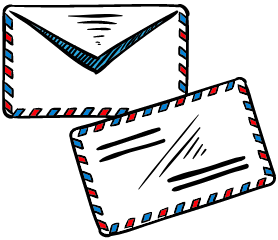Every once in a while my knitter friends have a friendly contest for finishing UFOs (UnFinished Objects, a.k.a WIPs or Works in Progress). Sometimes there is a prize for finishing the oldest UFO in one’s possession.
Do you have UFOs on your desk or in your files?
- conference papers you meant to turn into articles
- drafts that need revising
- manuscripts that got a “revise and resubmit”
- rejected manuscripts you mean to revise and submit to a different journal
Are those projects preventing you from starting new things? Are they weighing on you? Do you feel like you should really get to them even though the thought of actually working on them seems to send you to the nearest fiddly and absorbing administrative task?
You don’t have to finish them
Sometimes that sweater you started knitting 2 years ago, is just not the right style or colour, or you chose some really itchy yarn that you know you won’t wear. You can rip it out and give the yarn away (or throw it out).
You can do the same with your unfinished writing projects.
Some of them will be worth finishing. Others have served their purpose. You’ve learned what you needed to learn.
- The conference paper version helped you make a few connections or figure something out and never has to become a journal article.
- The paper stalled at the draft stage for a good reason. The argument just didn’t work. The evidence wasn’t there. Whatever.
- Maybe the time has just passed. Both the debate and your thinking have moved on.
Letting those papers go will probably be a relief. It will take off a weight you didn’t even know you were carrying and open up the space to write other things.
You don’t want to just abandon everything, though. You need to make conscious decisions about your writing UFOs.
Take stock
Make a list of all the unfinished papers you have lying around (virtually or on paper). Adding it to the list does not commit you to do anything at all with it. It just helps you see the scope.
Is there anything on that list that gets you really excited or happy? Any projects that make you feel like you do when you bump into an old friend you haven’t seen in a while and really like? Mark those with a star or a smiley face or circle in your favourite colour or something.
How about items that make your heart sink? Anything giving you that feeling of dread that you can feel in your gut? Don’t worry about whether you have a good reason to feel like that. Just note that this is how that project makes you feel. A storm cloud or frowning face or circling it in grey might be an appropriate way to indicate that visually. You could even cross these items out. (Use pencil if you want to be able to reconsider.)
Make some decisions
You can now start to make conscious decisions about what you really want to finish and what can be abandoned.
Anything with a star deserves to have some time allocated to it to figure out what needs to be done and whether you can do it. Prioritize those projects that make you happy.
Anything with a storm cloud could be crossed off without further investigation. The amount of effort it will take to even look at the draft is considerable. It will be hard to motivate yourself to work on it. It will be hard to actually do the work. The collateral damage to other projects will be significant.
Exception: Storm cloud projects that are fairly recent “revise and resubmit” decisions might be worth the effort. Seriously consider asking a colleague to help, especially if it is the reviewers’ comments that are making your heart sink. Getting perspective on what you need to do and what you can ignore (especially if the tone is unhelpful) can help.
I’ve got a class, Dealing With Reviewer Comments that can walk you through the process of making the necessary decisions. See also: How can reviewer comments improve your work? and Managing Manuscript edits
Make a real commitment
You can’t realistically keep more than 3 projects going at a time but it may be beneficial to have more than one so that you can change your focus when you get stuck on one.
If you don’t have enough starred projects to fill this out, then make a list of all the stuff you’d like to write but haven’t started yet. Or, use rational criteria to make decisions about some of the UFOs that didn’t evoke strong emotions:
- How central is it to your research program?
- How significant a contribution to the literature will this be?
- Have you had positive feedback?
- How much work does it need?
Choose a reasonable time period. 6 weeks is probably good. You can re-evaluate at the end of the 6 weeks and make new decisions. You aren’t committing to finishing these things in 6 weeks, just to giving them attention over the next 6 weeks and moving them forward.
Now actually book appointments with yourself to work on them. In your calendar. If you can’t find time to work on them, you aren’t really making a commitment. You don’t have to specify which one you’ll work on, but you do need time blocked off to write.
Let go of the rest (for now)
Everything else on your list is not going to get your attention over the next 6 weeks.
Some of it, you may decide will never get your attention. Archive the files (paper and electronic). Delete/shred drafts you don’t need any more.
Some of it, you may come back to. Tidy the files and put them away. You can pull them out again later but this does not need to be in the space you reserve for active projects.
Keeping your commitment
 If you would benefit from some support to make and keep that commitment, and one of our meeting times works, A Meeting With Your Writing, part of the Academic Writing Studio, provides you with an appointment you want to keep, encouragement and tips on getting back into that old project, and a group who will cheer your progress.
If you would benefit from some support to make and keep that commitment, and one of our meeting times works, A Meeting With Your Writing, part of the Academic Writing Studio, provides you with an appointment you want to keep, encouragement and tips on getting back into that old project, and a group who will cheer your progress.
One of the participants in A Meeting With Your Writing worked on projects she had been procrastinating on for a long time, before she retired. Projects that might otherwise been abandoned. Many of them, including one she first wrote as a post-doc, have now been published.
Related Posts:
Edited 6 November 2024 and Feb 2, 2016.








I started knitting almost 30 years ago when I went to a creative writing program and my writing life and knitting life are profoundly intertwined, as I used knitting as an activity that would keep me awake and in a room while I thought about what I needed to write. I’ve had long periods where knitting replaced poems, dissertation chapters and proposals and I’ve used knitting as a calming device when I was too stressed – so knit a row/write a few words or read a sentence. I have many knitting ufo’s that do or don’t get made so this analogy is wonderful – helps put the projects into perspective……
I hadn’t thought of that kind of intimate link between knitting and writing but it makes so much sense, Kathryn. Thank you for sharing that.